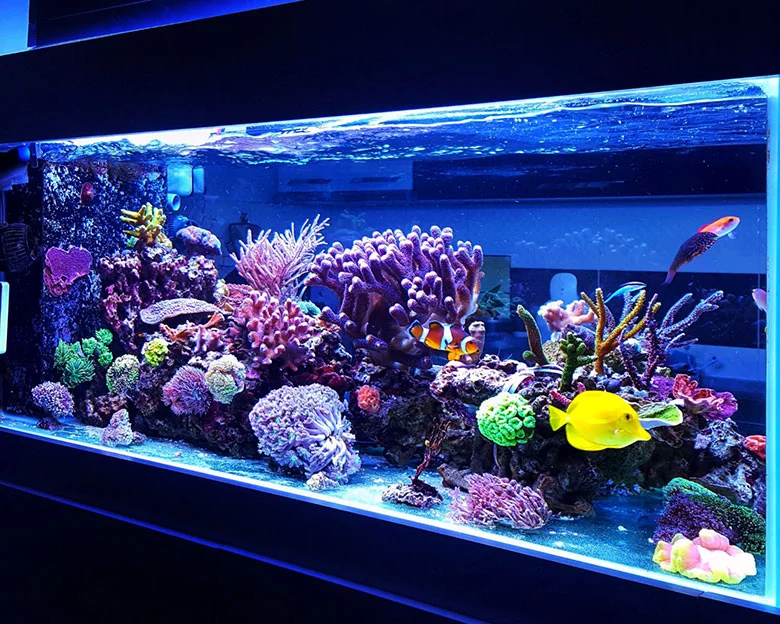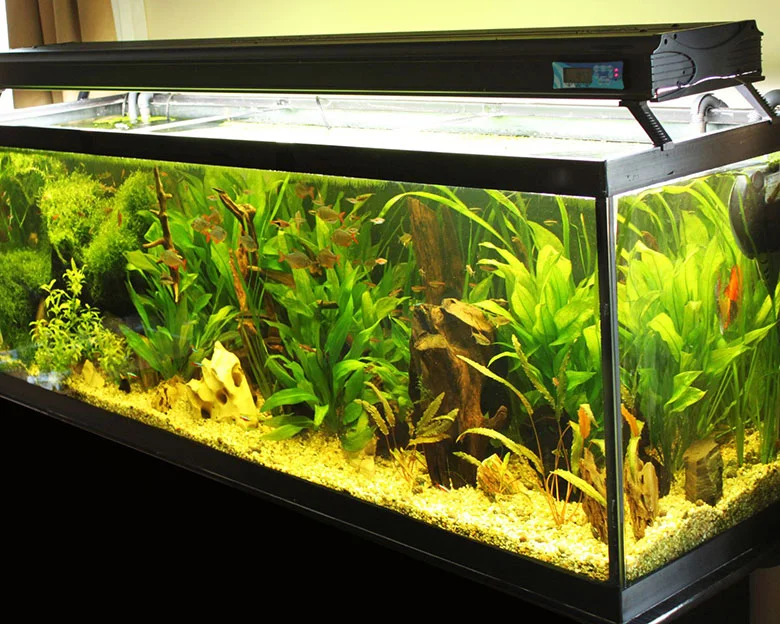Are you struggling to find the perfect lighting solution, whether it’s aquarium lights vs grow lights, for your plants? The battle between aquarium lights and grow lights has left many gardeners puzzled. But fear not, for we are here to shed some light on this matter!
In this article, we will delve into the world of aquarium lights and grow lights, exploring their differences and helping you make an informed decision.
Picture this: a lush, vibrant underwater paradise teeming with colorful fish and aquatic plants. Aquarium lights, with their bright white to blue glow, create a visually stunning spectacle. But here’s the catch – while they may be visually appealing, they might not provide the optimal conditions for plant growth.
On the other hand, grow lights are specifically designed to cater to the needs of terrestrial plants. With their balanced spectrum of red and blue light, similar to sunlight, they promote optimal growth and flowering. T5 High Output fluorescent tubes and LED lights are two popular options for grow lights.
So, which one should you choose? Join us as we dive deeper into the world of aquarium lights and grow lights, helping you make the best decision for your beloved plants. Let’s illuminate your path to successful plant growth!
Key Takeaways
- Aquarium lights are more appealing but not ideal for plant growth, while grow lights provide the optimal spectrum for photosynthesis.
- Kelvin rating between 4,700k to 6,700k is recommended for grow lights, while reef and marine tanks require a Kelvin rating above 8,000k.
- T5 HO fluorescent tubes are a popular choice for grow lights and can also be used for aquarium lighting, as they provide strong light for growth and flowering.
- LED lights are long-lasting and more energy-efficient than T5 HO fluorescents, but they are more expensive to buy.
Aquarium Lights

If you want your aquarium to look more appealing, but not necessarily support optimal plant growth, you should choose aquarium lights. These lights produce bright white to blue light, creating a visually pleasing environment for your fish and aquatic plants. However, it’s important to note that aquarium lights aren’t ideal for plant growth. They can be used to grow terrestrial plants, but better results can be achieved with horticultural lighting.
Kelvin ratings are important when it comes to aquarium lights, especially for reef and marine tanks. A Kelvin rating above 8,000k is recommended for these tanks. So, while aquarium lights can enhance the aesthetics of your aquarium, they may not provide the necessary light spectrum for optimal plant growth.
Grow Lights
Invest in the radiant power of horticultural lighting, where a captivating dance of reds and blues will ignite your plants’ growth like a symphony of sunrise and sunset. When it comes to choosing the right grow light for indoor gardening, LED grow lights offer a multitude of benefits. LED lights provide a balanced spectrum of light that closely mimics the sun, promoting optimal growth and flowering.
They are cool-operating and energy-efficient, making them a cost-effective choice in the long run. LED lights also have a longer lifespan compared to other types of grow lights, saving you money on replacements. To help you understand the advantages of LED grow lights more easily, here is a visual representation in the form of a table:
| Benefits of LED Grow Lights |
|---|
| Energy-efficient |
| Longer lifespan |
| Balanced spectrum |
With these benefits in mind, LED grow lights are a top choice for indoor gardeners looking to provide their plants with the ideal lighting conditions for healthy and abundant growth.
T5 HO Fluorescent Tubes
Consider using T5 HO fluorescent tubes as they’re a popular and cost-effective option for providing strong and long-lasting light for optimal growth and flowering. T5 HO fluorescent tubes have a kelvin rating between 4,700k to 6,700k, which is ideal for photosynthesis and plant growth.
These tubes emit a balanced spectrum of blue and red light, which is crucial for promoting growth and flowering in plants. Compared to LED lights, T5 HO fluorescent tubes are more economical to run and have a longer lifespan of approximately 22,000 hours.
When it comes to aquarium lighting, T5 HO fluorescent tubes offer several benefits:
- They provide sufficient light intensity for aquatic plants to thrive.
- The balanced spectrum of light promotes healthy growth and vibrant colors in both fish and plants.
- T5 HO fluorescent tubes are a cost-effective option, making them a popular choice among aquarium enthusiasts.
In comparison to LED lights, T5 HO fluorescent tubes are less expensive to purchase and operate. However, LED lights are more energy-efficient and have a longer lifespan. Ultimately, the choice between T5 HO fluorescent tubes and LED lights depends on your specific needs and budget.
LED Lights
Upgrade to LED lights for your tank and enjoy their cool-operating nature and energy efficiency, as they’ve been found to be more cost-effective in the long run.
LED grow lights have several advantages over other types of grow lights. One major advantage is their energy efficiency, as they consume less electricity compared to T5 HO fluorescent tubes. This not only saves you money on your energy bills but also reduces your carbon footprint.
LED grow lights also produce little heat, which is beneficial for your plants as it prevents overheating and reduces the risk of plant damage. Additionally, LED lights have a longer lifespan compared to other types of grow lights, meaning you won’t have to replace them as frequently.
However, it’s important to note that LED lights are more expensive to purchase initially. Despite this, their energy efficiency and longevity make them a cost-effective choice in the long run.

Frequently Asked Questions
What Is The Difference Between Lumens And Watts When Measuring Lighting?
Lumens and watts are both measurements used to evaluate lighting, but they represent different aspects. Lumens measure the amount of visible light produced by a light source, while watts measure the amount of electricity consumed by the light source.
When it comes to proper lighting for plant growth, understanding the difference between lumens and watts is crucial. While lumens indicate the brightness of the light, watts indicate the energy consumption. Therefore, it’s important to consider both factors when selecting the right lighting for your plants.
How Do I Choose The Right Lighting For An Aquarium Without Live Plants?
To choose the right lighting for an aquarium without live plants, there are a few key factors to consider. First, think about the preferences of your fish and other tank residents. Some species may prefer dimmer lighting, while others may thrive in brighter conditions.
Additionally, consider the overall setup of your tank. If you have decorative elements like rocks or driftwood, you’ll want to ensure they’re well-lit and visually appealing. Lastly, take into account the type of lighting that suits your budget and energy efficiency needs.
By considering these factors, you can choose lighting that enhances the beauty of your aquarium without live plants.
What Factors Should I Consider When Choosing Lighting For A Tank With Live Plants?
When choosing lighting for a tank with live plants, there are several factors to consider. First, you need to determine the type of lighting that’s best suited for plant growth. T5 HO fluorescent tubes are a popular choice as they provide a balanced spectrum of light for optimal growth and flowering.
LED lights are also a good option, as they’re long-lasting and energy-efficient. Additionally, you should consider the specific needs of your plants, such as the required Kelvin rating and the amount of light they need.
What Considerations Should I Keep In Mind When Lighting A Paludarium With Livestock And Terrestrial Plants?
When lighting a paludarium with livestock and terrestrial plants, there are several important considerations to keep in mind.
First and foremost, choose the right lighting that meets the specific needs of both the livestock and plants. Take into account the light intensity, spectrum, and duration required for optimal growth and health.
Additionally, consider the heat output of the lighting system and ensure proper ventilation to prevent overheating. It’s also crucial to regularly monitor and adjust the lighting to accommodate any changes in the paludarium’s inhabitants and their lighting requirements.
Can You Provide Any Tips Or Advice For Overcoming The Challenges Of Lighting A Tank, Depending On The Setup?
To optimize lighting for different types of plants in an aquarium, there are several tips for overcoming lighting challenges in a tank setup. Firstly, determine the specific lighting needs of your plants by researching their light requirements.
Then, choose the appropriate type of lighting, such as T5 HO fluorescent tubes or LED lights, based on the specific needs of your plants. Additionally, consider the distance and duration of lighting to ensure proper coverage and avoid overexposure. Regularly monitor plant growth and adjust lighting accordingly.

